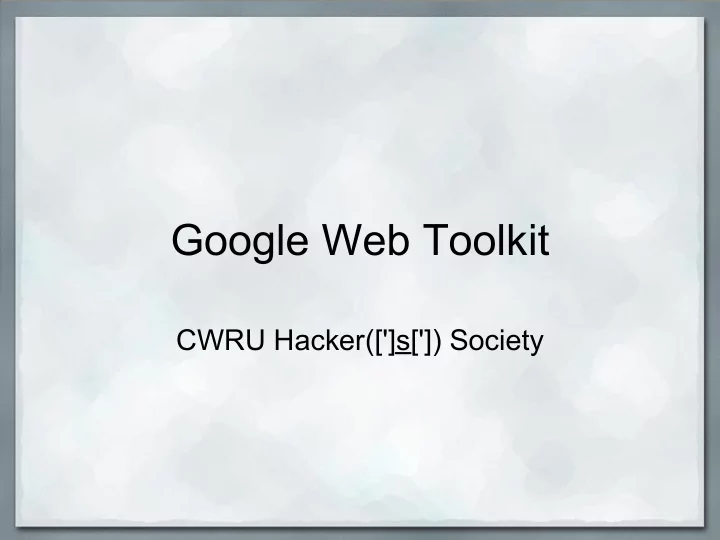

Google Web Toolkit CWRU Hacker([']s[']) Society
What is GWT? (By the way, it's free and open source under Apache License v2.0.) Questions to be Answered: ● Why? ● Brief Example Demonstration ● What can it do? ● How does it work?
Quick Background: Model-View-Presenter
Web Applications In the before time, in the long, long ago... Problems: ● Server is a bottleneck ● Latency
Case in Point:
Solution: Move Processing to Client (Also keep model cached locally, for responsiveness) Oops, now we have full-fledged applications running in the browser (written in a "scripting language")!
Writing a Web Application is Easy*! All you need to do is learn: ● HTML/XML ● CSS ● JavaScript ● Server Language (Java, Python, etc.) Then, write a bunch of interfaces to pass data between the server and client (e.g. using AJAX). Finally, don't forget to learn about the nuanced differences between the implementations of HTML/CSS/JavaScript, garbage collection, etc. on various browsers! (Testing and debugging this application will also be easy.) *Sarcasm
Split the Bill
Widgets, Widgets Everywhere ● Think of Java Components in AWT/Swing ● Can be completely specified in Java, but are compiled into JavaScript, CSS and HTML ● Compiled differently for different browsers (e.g. rounded corners) ● GWT comes with bunch of widgets, but you can write your own widget libraries, or use others
Java isn't always the best option... UIBinder: ● Allows specifying layout and style in an XML file ● Control code is placed in a Java class, the the compiler "binds" the two together ● Good design pattern (MVP again) ● Some boilerplate, but Eclipse can generate it for you
<- History -> ● Support for Back/Forward operations in browser ● History state manager (like an Undo Manager)
Resource Bundling ● Put a bunch of static resources inside a single object ● Prevent browser from requesting a brazilian tiny resources ● Can be icons or strings (e.g. for externalization) ● Also takes care of caching, etc.
So you're a JS Guru/Ninja... public static native void alert(String msg) /*-{ $wnd.alert(msg); }-*/; Don't worry, use can still use native JS (if you must)
Code Splitting ● Don't download the entire application at once! ● Liberally apply the following pattern: GWT.runAsync(new RunAsyncCallback() { public void onFailure(Throwable caught) { Window.alert("Code download failed"); } public void onSuccess() { Window.alert("Hello, AJAX"); } }); ● The compiler will figure out how to split up your code ● You can pre-fetch code, if necessary
GWT RPC FTW! ● Allows calling Java methods on server directly from client code, asynchronously ● Serialization/Deserialization of objects handled automatically by compiler ● You're not limited to using this to make requests from the server.
Testing and Debugging ● GWT Supports Unit Testing ● Run the web application in "hosted mode" ● Supports "hot swapping" code ● Put a breakpoint in your code. Mind. Blown.
Some Technical Stuff ● Generating multiple compiler outputs ○ Uses a technique called "Deferred Binding" <module> <!-- Fall through to this rule is the browser isn't IE or Mozilla --> <replace-with class="com.google.gwt.user.client.ui.impl.PopupImpl"> <when-type-is class="com.google.gwt.user.client.ui.impl.PopupImpl"/> </replace-with> <!-- Mozilla needs a different implementation due to issue #410 --> <replace-with class="com.google.gwt.user.client.ui.impl.PopupImplMozilla"> <when-type-is class="com.google.gwt.user.client.ui.impl.PopupImpl" /> <any> <when-property-is name="user.agent" value="gecko"/> <when-property-is name="user.agent" value="gecko1_8" /> </any> </replace-with> <!-- IE has a completely different popup implementation --> <replace-with class="com.google.gwt.user.client.ui.impl.PopupImplIE6"> <when-type-is class="com.google.gwt.user.client.ui.impl.PopupImpl"/> <when-property-is name="user.agent" value="ie6" /> </replace-with> </module> (You usually don't have to worry about doing this.)
Compiler Principles/Optimizations ● "Don't do at runtime what you can do with a compiler." ● Obfuscated JavaScript/CSS code is minimized and optimized for compression. ● Minimize DOM operations by compiling into HTML as much as possible (as in UIBinder)
Conclusions ● GWT makes it much easier to create powerful, efficient web applications ○ Compile Java to browser-specific "native" code ○ MVP encouraged through UIBinder ○ Code Splitting, Compiler Optimizations, Resource Bundles ○ Development and Testing Tools ● Plenty of good tutorials available online for specifics
Thank You! Questions/Discussion? GWT Home: http://code.google.com/webtoolkit/ Example Application: http://split-bill.appspot.com/ Example Source: http://code.google.com/p/split-the-bill/
Recommend
More recommend